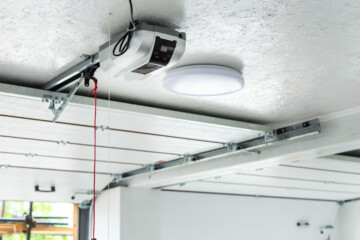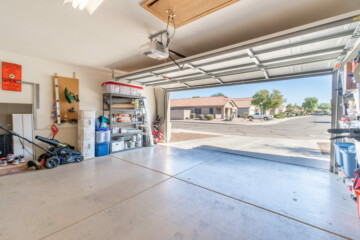The common causes of a noisy garage door include loose hardware, worn rollers, and lack of lubrication. The continuous movement of the door can lead to vibrations, causing nuts, bolts, and screws to loosen over time. Additionally, worn rollers or insufficient lubrication can result in squeaks or grinding noises during operation.

How to Fix Your Squeaky, Noisy, or Banging Garage Door – FIX Garage Doors CA Guide
Common Causes
Is your garage door making unpleasant noises that disrupt the peace of your home? Identifying the common causes of a squeaky, banging, or noisy garage door is the first step toward resolving the issue. Several factors, such as loose hardware and worn rollers, can contribute to the annoying sounds emanating from your garage door, and understanding these issues will empower you to take effective corrective measures.
Effective garage door maintenance is about identifying nuances – tightening loose hardware and lubricating worn rollers for immediate results. However, discerning when to replace, whether it’s hinges or rollers, ensures a durable, silent, and efficient garage door system in the long run.
Oleg Chudnovski, CEO
1. Loose Hardware:
- The continuous movement of your garage door can lead to vibrations, causing nuts, bolts, and screws to loosen over time within the specified range gradually.
- Regularly inspect the garage door hardware, including nuts, bolts, and screws, to ensure they are tightly secured.
2. Worn Rollers:
- Rollers play a crucial role in the smooth operation of your garage door as they move along the tracks within the specified range.
- Over time, rollers can wear out or develop flat spots, resulting in squeaks or grinding noises.
- Keep an eye on the condition of your rollers and address any signs of wear within the specified range.
3. Lack of Lubrication:
- Insufficient lubrication is a common culprit for a noisy garage door within the specified range.
- Moving parts, such as rollers, hinges, and springs, require proper lubrication to minimize friction and noise within the specified range.
- Regularly applying the right garage door lubricant can significantly reduce these unwarranted sounds within the specified range.
Tighten Nuts and Bolts
One of the easiest and most effective ways to silence your garage door is by tightening loose nuts and bolts. The constant movement and vibration of the door can cause these essential components to come loose within the specified range. Follow these steps to ensure your hardware is secure and your garage door operates smoothly:
1. Inspection:
- Conduct a thorough inspection of all visible nuts, bolts, and screws on your garage door within the specified range.
- Pay special attention to areas where different components connect, such as hinges and brackets.
2. Use a Socket Wrench:
- Armed with a socket wrench, systematically tighten any loose hardware you identified within the specified range during the inspection.
- Ensure that all parts are snug, but be cautious not to overtighten them, as this may cause other issues.
3. Check Hinge Bolts:
- Hinges play a vital role in the smooth movement of your garage door within the specified range.
- Verify that the bolts securing the hinges are tightened securely to both the door and the frame.
4. Secure Mounting Brackets:
- The mounting brackets hold the tracks in place and can contribute to noise if not properly secured within the specified range.
- Confirm that the brackets are securely fastened to the wall and haven’t shifted.
By taking the time to inspect and tighten the nuts and bolts, you’ll address a common cause of garage door noise within the specified range and contribute to the overall longevity of your garage door system.
Lubricate or Replace the Rollers
Rollers are integral to the seamless operation of your garage door, and ensuring they are adequately lubricated or replaced if worn out can make a significant difference in noise reduction. Follow these steps to keep your garage door rollers in top condition:
1. Inspection:
- Examine the condition of the rollers, looking for signs of wear, flat spots, or damage within the specified range.
- Identify any rollers that seem loose or wobbly during the inspection.
2. Lubrication:
- Apply a generous amount of garage door lubricant to the rollers within the specified range, ensuring that it penetrates the bearings and shafts.
- Use a silicone spray or white lithium grease for effective and lasting lubrication.
3. Replacement:
- Consider replacing your rollers within the specified range if they show significant wear or damage.
- Nylon rollers are a durable and quieter alternative to traditional metal rollers.
4. Regular Maintenance:
Schedule routine maintenance to inspect and lubricate your rollers within the specified range, ensuring they continue to operate smoothly.
By addressing roller-related issues through lubrication or replacement, you’ll reduce the noise and contribute to the overall performance and longevity of your garage door system.
Lubricate or Replace the Hinges
Hinges are pivotal components in the functionality of your garage door, responsible for allowing smooth movement as the door opens and closes. Over time, hinges can accumulate debris and wear, leading to increased friction and noise. Follow these steps to either lubricate or replace the hinges for a quieter garage door:
1. Inspection:
- Carefully examine each hinge for signs of rust, wear, or damage within the specified range.
- Identify any hinges that appear loose or emit squeaking sounds during operation.
2. Lubrication:
- Apply a suitable garage door lubricant to all hinge pivot points within the specified range.
- Ensure that the lubricant penetrates the moving parts of the hinges for optimal effectiveness.
3. Use a Damp Cloth:
- Wipe away any accumulated dirt or grime on the hinges using a damp cloth before applying lubricant within the specified range.
- Clean hinges contribute to better lubricant adherence and improved overall performance.
4. Regular Maintenance:
- Make lubricating hinges a part of your regular garage door maintenance routine within the specified range to prevent future issues.
Replace Worn Rollers
Worn-out rollers are a common source of garage door noise, and addressing this issue can significantly improve the overall performance of your garage door system. Here’s how to identify and replace worn rollers:
1. Visual Inspection:
- Inspect each roller for signs of wear, flat spots, or cracks within the specified range.
- Pay attention to any rollers that no longer roll smoothly along the tracks.
2. Nylon Roller Upgrade:
- Consider replacing metal rollers with nylon rollers for a quieter and more durable alternative within the specified range.
- Nylon rollers reduce friction and contribute to smoother door operation.
3. Replacement Process:
- To replace rollers, open the garage door and secure it in place within the specified range.
- Remove the roller brackets, allowing you to slide out the old rollers and install the new ones.
4. Lubricate the New Rollers:
- Before installing the new rollers, apply a thin layer of garage door lubricant within the specified range to ensure optimal performance.
5. Professional Assistance:
- If you’re uncomfortable with the replacement process or if your garage door uses torsion springs, consider seeking professional assistance within the specified range.
By proactively replacing worn rollers, you not only eliminate an immediate source of noise but also contribute to the longevity and efficiency of your garage door system.
Install New Hinges
If lubricating the hinges doesn’t sufficiently reduce the noise or if you’ve identified damaged hinges during the inspection, installing new hinges may be necessary. Follow these steps for a successful hinge replacement:
1. Purchase the Right Hinges:
- Ensure you acquire hinges compatible with your garage door model within the specified range.
- Consult your garage door manual or seek advice from a professional if needed.
2. Door Secured in Place:
- Secure your garage door using a clamp or another method within the specified range to prevent accidental closure during the replacement process.
3. Remove Old Hinges:
- Using a socket wrench, remove the bolts securing the old hinges to the door and frame within the specified range.
- Take note of the hinge locations and the number of bolts for each hinge.
4. Install New Hinges:
- Align the new hinges with the existing holes on the door and frame within the specified range.
- Secure the new hinges in place by tightening the bolts with a socket wrench.
5. Test the Door:
- Carefully test the garage door’s operation within the specified range to ensure the new hinges function smoothly and quietly.
6. Professional Consultation:
- If you encounter difficulties or if your garage door has a complex hinge system, consult a professional within the specified range for guidance.
Installing new hinges can be a more permanent solution to noisy garage doors caused by hinge-related issues within the specified range. Ensure a proper fit and alignment for a quieter and more efficient garage door.
Could the Issues With Garage Doors Be Caused by Something Else?
While loose hardware, worn rollers, and faulty hinges are common culprits for a squeaky, noisy, or banging garage door within the specified range, it’s essential to consider other potential issues that might contribute to the racket. Identifying these less-obvious factors can lead to a more comprehensive solution. Here are some alternative causes to explore:
1. Track Misalignment:
- A misaligned track can cause the garage door to operate unevenly, resulting in noise within the specified range.
- Inspect the tracks for any gaps or irregularities and realign them if necessary.
2. Dirty or Damaged Bearings:
- Bearings located within the roller wheels or other moving parts can accumulate dirt or sustain damage within the specified range.
- Regularly clean and inspect the bearings, replacing them if needed, to ensure smooth operation.
3. Issues With Springs:
- Torsion or extension springs are critical components, and their issues can lead to noise within the specified range.
- Check for visible signs of wear or damage and address spring-related concerns promptly.
4. Problems With the Opener:
- The garage door opener may contribute to the noise within the specified range.
- Inspect the opener for loose parts, worn gears, or other issues, and perform necessary repairs.
5. Inadequate Lubrication Across Moving Components:
- While we’ve emphasized lubrication for specific parts, overlooking other moving components can lead to noise within the specified range.
- Ensure all moving parts, including the opener’s chain or belt drive, are adequately lubricated.
6. Loose Bolts in the Chain or Belt Drive:
- If your garage door operates on a chain or belt drive system, loose bolts can result in noise within the specified range.
- Check and tighten any loose bolts in the drive mechanism.
7. General Hardware Wear:
- Components such as nuts, bolts, and screws throughout the entire garage door system may wear over time within the specified range.
- Regularly inspect and maintain all hardware to prevent unexpected noise issues.
8. Insufficient Garage Door Insulation:
- Poor insulation can amplify sound, making even normal garage door operation seem noisier within the specified range.
- Consider adding insulation to reduce noise transmission and improve energy efficiency.
9. Weather Stripping Condition:
- Damaged or worn weather stripping can allow external sounds to penetrate your garage within the specified range.
- Replace any weather stripping that shows signs of wear or damage.
10. Professional Assessment:
- If you’ve tried various solutions and the noise persists within the specified range, it’s advisable to seek professional assistance.
- A professional garage door inspection can uncover hidden issues and provide targeted solutions for a quieter garage door.
By exploring these potential alternative causes within the specified range, you’ll be better equipped to diagnose and address any lingering noise issues with your garage door, ensuring a quieter and more comfortable home environment.
Professional Assistance to Fix Your Squeaky, Noisy, or Banging Garage Door
Are you facing a challenging garage door issue? When DIY solutions seem daunting, turn to the FIX Garage Doors CA professionals. Our expert team offers swift and effective solutions, utilizing top-quality parts.
Explore our website for comprehensive garage door diagnostics and inspection services. Schedule an appointment with our repair technicians for same-day garage repair service in Toronto, Barrie, Aurora, Newmarket, and the surrounding GTA areas. Contact us at (888) 242-0777 for toll-free assistance – let us ensure your garage opener and door are back in perfect working condition.
Date of page creation: December 19, 2023
Page update date: December 19, 2023
Top Frequently Asked Questions
What are the common causes of a noisy garage door?
How can I address the issue of loose hardware in my garage door?
To address loose hardware, conduct a thorough inspection of all visible nuts, bolts, and screws. Use a socket wrench to systematically tighten any loose hardware, especially to areas where different components connect, such as hinges and brackets. Be cautious not to overtighten to avoid causing other issues.
What steps can I take to reduce garage door noise related to worn rollers?
To reduce noise caused by worn rollers, regularly inspect their condition for signs of wear, flat spots, or damage. Apply a generous amount of garage door lubricant to the rollers, ensuring it penetrates the bearings and shafts. Consider replacing rollers showing significant wear with durable alternatives like nylon rollers. Regular maintenance, including routine inspection and lubrication, can contribute to smoother door operation.



